
The Battle of Lund, part of the Scanian War, was fought on December 4, 1676, in an area north of the city of Lund in Scania in southern Sweden, between the invading Danish army and the army of Charles XI of Sweden. The Danish had an army of about 13,000 under the personal command of 31-year-old King Christian V of Denmark, aided by General Carl von Arensdorff. The Swedish army, which numbered about 8,000, was commanded by Field Marshal Simon Grundel-Helmfelt and the 21-year-old Swedish king Charles XI. It is one of the bloodiest battles in percent of casualties on both sides ever fought in Scandinavia.
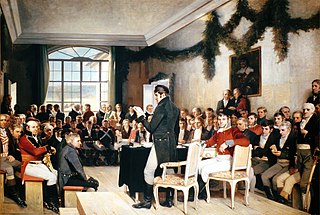
The Swedish–Norwegian War, also known as the Campaign against Norway, War with Sweden 1814, or the Norwegian War of Independence, was a war fought between Sweden and Norway in the summer of 1814. According to the Treaty of Kiel, Norway would enter a union with Sweden under Charles XIII of Sweden. The war resulted in Norway being forced into the United Kingdoms of Sweden and Norway, but with its own constitution and parliament. The war marked the last time Sweden participated in an armed conflict with another nation, and its conclusion signalled the beginning of the country's long period of military neutrality.
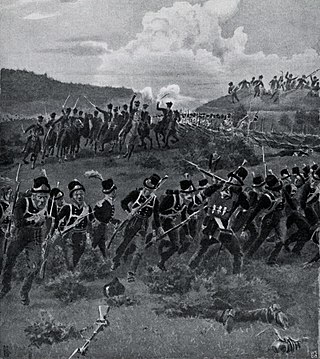
The Battle of Lier was fought on 2 August 1814 between Sweden and the newly independent Norway as part of the Swedish-Norwegian War of 1814. The battle was the first major action of the war, in which an outnumbered Swedish force attempted to storm the Norwegian entrenchment; the Norwegian victory served as an important part to boost morale among the Norwegian troops. This was the second time during the Napoleonic Wars that a battle had taken place at Lier, the first was in 1808.
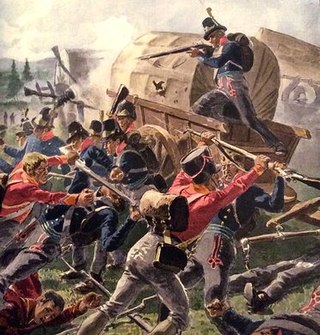
The Battle of Matrand was a military battle on 5 August 1814 between Norwegian and Swedish forces as part of the Swedish-Norwegian War of 1814. The battle took place near the village of Matrand in Eidskog and at Skotterud. It was the bloodiest battle of the entire war, in which the Swedes lost more than 340 men, of which 270 were captured; the Norwegians lost around 50 men with 90 wounded and 36 captured.
Johan Christopher Ræder was a Norwegian military officer. He was of German and Danish descent, and partly served in the Danish army.
Johan Georg Ræder was a Norwegian military officer.
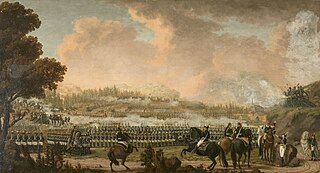
Battle of Valkeala took place in Gustav III's Russian War April 29, 1790 at Valkeala in Kymenlaakso in Southern Finland and ended with a Swedish victory.
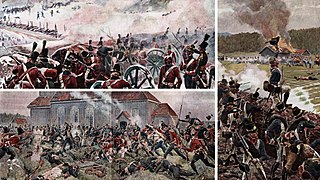
The Dano–Swedish War of 1808–1809 was a war between Denmark–Norway and Sweden due to Denmark–Norway's alliance with France and Sweden's alliance with the United Kingdom during the Napoleonic Wars. Neither Sweden nor Denmark-Norway had wanted war to begin with but once pushed into it through their respective alliances, Sweden made a bid to acquire Norway by way of invasion while Denmark-Norway made ill-fated attempts to reconquer territories lost to Sweden in the 17th century. Peace was concluded on grounds of status quo ante bellum on 10 December 1809.

The Battle of Langnes, or the Battle of Langnes Entrenchment, was fought between Norway and Sweden as a part of the Swedish-Norwegian War of 1814. The battle, even as it ended inconclusively, served as a tactical victory to the Norwegians since they now could avoid an unconditional surrender to the Swedish.
Bernhard Ditlef von Staffeldt was born on 23 October 1753 in Kenz, Swedish Pomerania, as the son of Lieutenant Bernt von Staffeldt, of Pomeranian nobility, and Catherine Eleonore von Platen. Both his parents died in 1755 while he was still a child; he was raised at his married sister's estate in Denmark and was taken into the court of Queen Sophia Magdalene of Brandenburg-Kulmbach in 1767.
The Battle of Rødenes was a series of skirmishes that took place in late April and early May 1808 from Lund in Hemnes to Ørje as a result of the Swedish invasion of Norway during the Dano-Swedish War of 1808-1809.
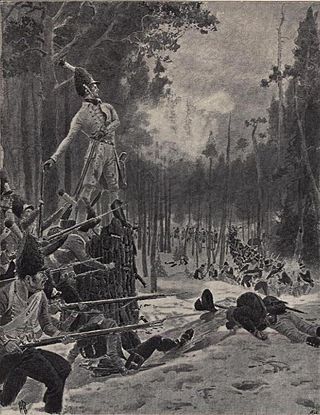
Nicolay Peter Dreyer was a Norwegian military officer with the rank of captain. He was born in Fosnes. He became a legend during the Battle of Trangen on 25 April 1808, leading his infantry regiment first from a roof, then from a tree stump with the height of a man. The stump was later named after him, a series of myths developed after his death, and he became a national symbol in 1814 and in 1905.

The Battle of Kjølberg Bridge was fought 14 August 1814, during the Swedish–Norwegian war of 1814. The Swedish army had problems repairing the bridge due to constant fire from the Norwegian side of the river. It was then a small Swedish force of 75 men, consisting of jägers from the Bohuslän and Life Grenadier Regiments, passed over the river at a hidden point. Once over they waited for reinforcements but none came; but instead the order of attacking the vastly larger Norwegian force. The Colonel response to the attack order have been famous "It is unreasonable to attack with only 75 men when you face a whole regiment." "But such an order isn't given to me twice. March!" During cheers the Swedes rushed up the hill toward the mansion that was occupied with 600 men. The attack was surprising and decisive. As more Swedish troops crossed, the Norwegians quickly left the stand. This was the last battle fought during the Swedish–Norwegian War. The Convention of Moss, providing a cease fire agreement, was signed that same day.

The Jämtland Campaigns of 1808–1809 were two Dano-Norwegian military campaigns into the Swedish province of Jämtland during the Dano-Swedish War of 1808-1809.
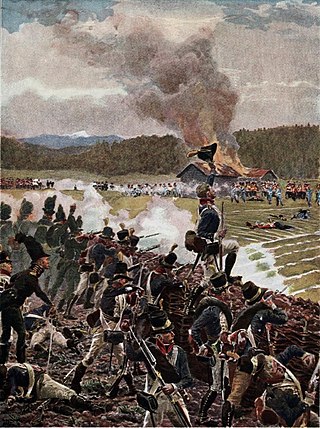
The Battle of Mobekk was fought on 18 May 1808 between Swedish and Norwegian forces, during the Swedish invasion of Norway. After the Swedish victory at Lier, Bernhard Ditlef von Staffeldt ordered Johan Georg Ræder to attack the right flank of Gustaf Mauritz Armfelt's brigade, along the Skinnarbøl river. The Norwegians managed to force a few Swedish outposts across the river, but met fierce resistance at the main Swedish redoubt at Mobekk; Ræder conducted three fruitless assaults before retreating with his force, after five hours of fighting. The battle had no strategic effect as Armfelt retreated out of Norway in May and June, after misinterpreting the orders from the Swedish king Gustav IV Adolf advocating for him to act defensively.

The Battle of Bysjön was fought between Swedish and, for the most part, Norwegian troops on 22 December 1644. The battle took place on the ice of the frozen Lake Bysjön in the parish of Eda in Värmland, Sweden. The battle was part of the Torstenson War (1643-1645), known locally as the Hannibal Feud (Hannibalsfejden) between Sweden and Denmark-Norway. The Danish-Norwegian victory meant the invading army could potentially continue into Värmland and Dalsland.
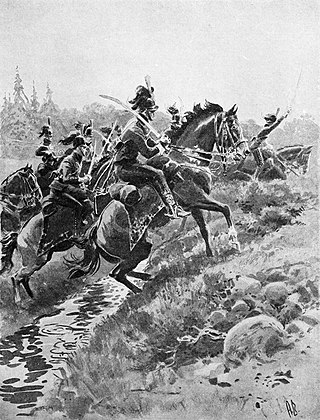
The Battle of Rakkestad was fought in the Swedish–Norwegian War of 1814, at the village of Rakkestad, Norway, between 2,000–3,000 Swedes force under Eberhard von Vegesack, and a slightly smaller Norwegian force, led by Frederik Wilhelm Stabell. The Swedish forces drove the Norwegians back from their fortified positions with a disciplined bayonet-attack and dealt them considerable losses. This battle crippled the morale of the Norwegian defenders, and especially their leader, King Christian Frederik, which contributed to a rapid end of the war, eight days later, with the Convention of Moss.

The Battle of Tistedalen was a series of skirmishes in the Swedish–Norwegian War of 1814, at Tistedalen, Norway.

The Battle of Lier was fought on 18 April 1808, between Swedish and Norwegian forces, during a Swedish invasion of Norway. The Swedes crossed the border in several brigades, of which the General-in-chief, Gustaf Mauritz Armfelt, followed the first; he arrived at the strong Norwegian position at Lier and decided to attack it, to reach Kongsvinger Fortress. Before launching the main attack, the Swedes made diversionary attacks on the flanks, of which the left one was particularly successful; Bernt Peter Kreutz, the Norwegian commander, reacted by shifting over troops to his threatened flank, which enabled the Swedes to capture his exposed right. Meanwhile, the Norwegian redoubt covering the road was likewise captured, as the Swedish main army swiftly attacked. Kreutz decided to retreat by the evening, fearing he would be cut off from the Kongsvinger fortress. Armfelt did not follow up his victory, instead he remained at Lier until late May, when he received orders to withdraw; the Swedes retreated out of Norway in May–June, after a fruitless campaign.

The Battle of Berby was fought on 12 September 1808, between Swedish and Norwegian forces, during the Dano-Swedish War of 1808–09. Ever since the Battle of Prestebakke, the western front had been relatively calm, until colonel Posse launched a reconnaissance towards the Norwegian positions around at Berby, under Andreas Samuel Krebs; the Swedes pushed the Norwegians in front of them, all the way to Berby itself, where the Norwegians made a sturdy hold. At that time, Posse requested a ceasefire, as his reconnaissance had essentially evolved into a larger encounter; krebs accepted and after half an hour, the Swedes went back across the border. The battle was the last significant engagement between Swedish and Norwegian forces, that year.



















